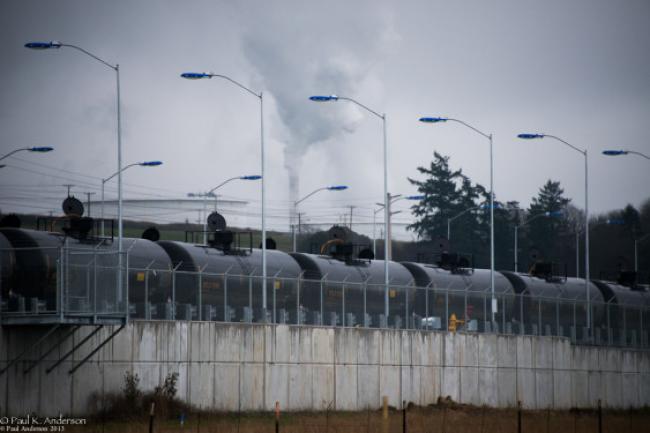Articles Menu

How much oil currently moves through the Northwest? Where does it come from and where is it going? What are the implications for Northwest communities and our waterways? And what are the next steps to ensure human safety, public health, and environmental protection? Sightline’s policy director and oil train expert, Eric de Place, recently sat down with Diane Horn on KEXP Mind Over Matters and shed light on the consequences of oil-by-rail transport in the Northwest. You can listen in here, but some highlights are below.
Why oil terminals are being proposed in the Northwest:
We are victims of our geography in the sense that we are pinched between these huge reserves of coal, oil, and gas in the middle of North America, and the world’s fastest growing energy markets in Asia. And because of the economics and the logistics of moving these products, it turns out that the oil, coal, and gas industries have to move their products through the Pacific Northwest if it’s going to find a market.
How much oil is moving through this region:
There is enough capacity built to handle 300,000-400,000 barrels of oil per day. What we also know is that the industry wants to build the capacity to handle over one million barrels of oil per day, which is way more than we can consume in this region. So what we’re seeing is an expansion of an industry that didn’t exist in 2012, which now wants to triple in size.
The climate implications of oil trains:
New oil infrastructure leads to more oil consumption. The proposed energy projects in the region would amount to a carbon equivalent of more than five Keystone XL Pipelines. By preventing the construction of new infrastructure, we can help keep carbon in the ground where it belongs.
The upcoming threats of fossil fuels in the Northwest:
The way I like to explain this is as a Tsunami with three waves. The first wave of the Tsunami was coal export terminals. The proposals started in 2011 and 2012; those are dying now. They’re not quite dead and we need to continue fighting them. The second wave is oil-by-rail. One million barrels per day is scheduled for the Northwest. We’re in the thick of that fight now. The third wave of that Tsunami is fracked fuels and petrochemicals. There’s going to be huge quantities of natural gas coming out of the American and Canadian Rockies and transported to Northwest ports where they will be liquefied and shipped to Asia. What we will see in 2015 and 2016 are big debates about natural gas. That’s going to be a hot fight.
We can win the fight against dirty energy:
There is a huge climate fight in the Pacific Northwest. What’s happening here has global consequences. Recent history has shown that public opposition can beat back the most dangerous proposals by the best funded industries on the planet. We can win right now. We’re driving coal companies to bankruptcy. We can win all of these fossil fuel fights in the Northwest.
Want to learn more?